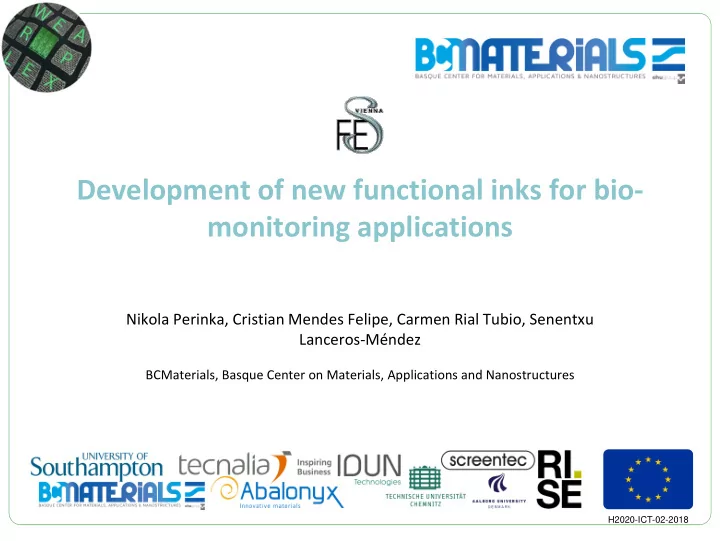

Development of new functional inks for bio- monitoring applications Nikola Perinka, Cristian Mendes Felipe, Carmen Rial Tubio, Senentxu Lanceros-Méndez BCMaterials, Basque Center on Materials, Applications and Nanostructures H2020-ICT-02-2018
2 Contents • 1. Introduction • 2. Results • 3. Prospects
3 Nanostructured Materials Active and Smart Materials • Magnetic nanoparticles produced by • Magnetic Shape Memory bacteria Alloys • Nanoparticles and nanostructures • Magnetocaloric (magnetic, metallic, dielectric…) • Elastocaloric • Porous materials (MOFs, Zeolites…) • Piezoelectric • Piezoresistive • Self-healing Micro & Nano-devices Functional Surfaces and Coatings • Radiofrequency instrumentation • Patterned surfaces and films • Force, deformation, • Ink-printed functional materials magnetic, magnetostrictive and chemical sensors Advanced Functional Materials • Fuel cells and batteries, Sensors & biosensors, Photovoltaic materials New materials and processing for permanent magnets
4 Biopolymer based inks Stress and Strain sensors Stretchable Flexible On different substrates Printed photodetectors Organic TFT based piezoresistive array Ag electrode PR Material Active material Encapsulation (c-PVP) Drain (Ag) OSC Source(Ag) Top eletrode (PEDOT:PPS) Dielectric (CPVP) Active material (OSC) Gate (Ag) Substrate (PEN) Bottom eletrode (Ag) Substrate (PEN)
5 Interactive touch surfaces Electroactive biomaterials Capacitive technology Muscle cells Piezoelectric differentiation Object technology recognition Soft Actuators
6 1. Introduction
7 Wearable multiplexed biomedical electrodes Offers interesting opportunities for advanced health solutions for bio-monitoring Biomonitoring device will be designed and integrating on different flexible and thin layer systems • Based on electroactive polymers • Conductive and • Functional inks Functional fillers semiconductive • Ensure biocompability ink formulation components • Water-based formulation • Stretchable
8 Strategy fabrication bio-monitoring devices Bioink synthesis 2D Printing Post-processing • Drying • • Components Design • Integration • • Stability Substrate • Mechanical • • Dispersion Screen-printing and chemical • • Rheology Ink-jet printing resistance
9 2. Results
10 Synthesis and characterization rGO based inks Active: Reduced graphene oxide (rGO) Binder: Based on cellulose derivates (or other water- Components ink soluble polymers) Solvent: EtOH+Desionized H2O Ink rheology tailored for printing techniques
11 Synthesis and characterization rGO based inks Active: Reduced graphene oxide (rGO) Binder: Based on cellulose derivates (or other water- Components ink soluble polymers) Solvent: EtOH+Desionized H2O Screen printing Inkjet printing Ink rheology tailored for printing techniques
12 Synthesis and characterization rGO based inks Active: Reduced graphene oxide (rGO) Binder: Based on cellulose derivates (or other water- Components ink soluble polymers) Solvent: EtOH+Desionized H2O Screen printing Inkjet printing Ink rheology tailored for printing techniques
13 Printing and characterization rGO based layers • Screen-printing technique Filler/binder ratio: 65/35 5 10 • High-concentration rGO based ink GN + CMC Resistance ( ) • PET substrate 4 10 Number of layers Thickness Sheet resistance El. Conductivity (roughness) ( kΩ /sq) (S/cm) ( μ m) 3 10.0 (3.1) 38 0.026 3 10 5 10 15 20 # Steps 10 10.4 (2.5) 22 0.044
14 Printing and characterization rGO based layers • Screen-printing technique • High-concentration rGO based ink • PET substrate Lamellas-like structures embedded in cellulose-based binder
15 Printing and characterization rGO based layers • Two prominent bands at ̴1350 and ̴1598 cm-1, corresponding to D (related defects) and G bands • Structrure of rGO confirmed *Substrate PET: Significant peak at 1580 cm-1
16 Alfa demonstrador with commercial inks • • Screen-printing PET substrate • • Commercial based inks Multilayer STEP 2 STEP 3 STEP 1 Conductive Semi-conductive Dielectric silver electrodes carbon layer protective layer
17 Alfa demonstrator with rGO ink • • Screen-printing PET substrate • • Graphene based inks Multilayer
18 3. Prospects
19 Future prospects • Development of conductive, semi-conductive and dielectric inks with improved bio-compatibility and stretchability for wearables applications • rGO ink optimization in terms: • Adhesion (implementation of other binders: hydrophobic or stretchable) • Chemical resistance (stable under in sweat conditions, pH) • Electrical conductivity • Development of semicondcutive inks with improved: • Electrical conductivity • Chemical resistance/stability • Electrochemical behaviour
20 Thank you!
Recommend
More recommend